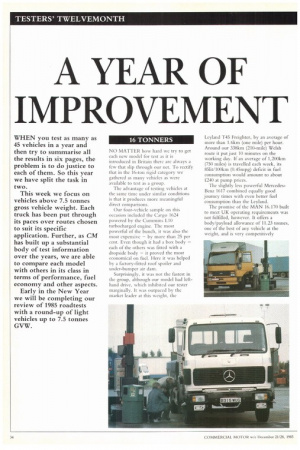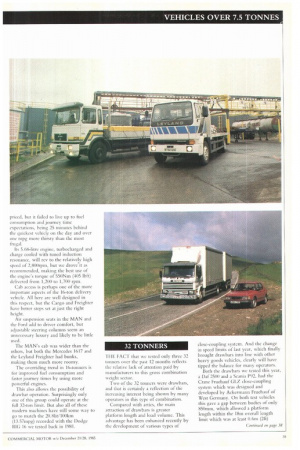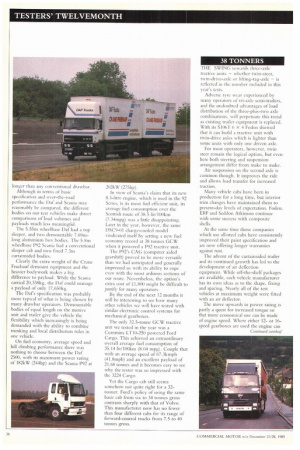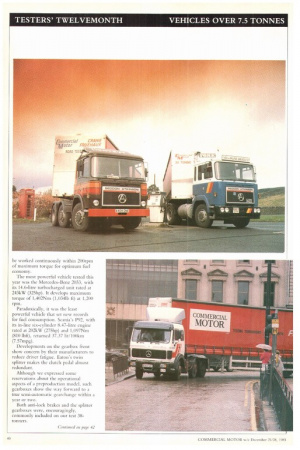A YEAR OF IMPROVEMENT
Page 36

Page 37

Page 40

Page 42

Page 44

If you've noticed an error in this article please click here to report it so we can fix it.
16 TONNERS
NO MATTER how hard we try to get each new model for test as it is introduced in Britain there are always a few that slip through our net. To rectify that in the I6-ton rigid category we gathered as many vehicles as were available to test as a group.
The advantage of resting vehicles at the same time under similar conditions is that it produces more meaningful direct comparisons.
Our four-vehicle sample on this occasion included the Cargo 1624 powered by the Cummins L10 turbocharged engine. The most powerful of the bunch, it was also the most expensive — by more than 25 per cent. Even though it had a box body — each of the others was fitted with a dropside body — it proved the most economical on fuel. Here it was helped by a factory-fitted roof spoiler and under-bumper air dam.
Surprisingly, it was not the fastest in the group, although our model had lefthand drive, which inhibited our tester marginally. It was outpaced by the market leader at this weight, the Leyland T45 Freighter, by an average of more than 1.6km (one mile) per hour. Around our 338km (210-mile) Welsh route it put just 10 minutes on the working day. If an average of 1,200krn (750 miles) is travelled each week, its 851it/100km (0.45mpg) deficit in fuel consumption would amount to about £240 at pump prices.
The slightly less powerful MercedesBenz 1617 combined equally good journey times with even better fuel consumption than the Leyland.
The promise of the MAN 16.170 built to meet UK operating requirements was not fulfilled, however. It offers a body/payload allowance of 11.23 tonnes, one of the best of any vehicle at the weight, and is very competitively priced, hut it failed to live up to fuel consumption and journey time expectations, being 25 minutes behind the quickest vehicle on the day and over one mpg more thirsty than the most frugal.
Its 5.68-litre engine, turbocharged and charge cooled with tuned induction resonance, will rev to the relatively high speed of 2,800rpm, but we drove it as recommended, making the best use of the engine's torque of 550Nm (405 lbft) delivered from 1,200 to 1,700 rpm.
Cab access is perhaps one of the more important aspects of the 16-ton delivery vehicle. All here are well designed in this respect, but the Cargo and Freighter have better steps set at just the right height.
Air suspension seats in the MAN and the Ford add to driver comfort, but adjustable steering columns seem an unnecessary luxury and likely to be little used.
The MAN's cab was wider than the others, but both the Mercedes 1617 and the Leyland Freighter had bunks, making them much more roomy.
The overriding trend in l6-tonners is for improved fuel consumption and faster journey times by using more powerful engines.
This also allows the possibility of drawbar operation. Surprisingly only one of this group could operate at the full 32-ton limit. But also all of these modern machines have still sonic way to go to match the 20.81it/100km (13.57mpg) recorded with the Dodge RIG 16 we tested back in 1981.
32 TONNERS
TI IL FACT that we tested only three 32 tonners over the past 12 months reflects the relative lack of attention paid by manufacturers to this gross combination weight sector.
Two of the 32 tonners were drawbars, and that is certainly a reflection of the increasing interest being shown by many operators in this type of combination.
Compared with artics, the main attraction of drawbars is greater platform length and load volume. This advantage has been enhanced recently by the development of various types of close-coupling system. And the change in speed limits of last year, which finally brought drawbars into line with other heavy goods vehicles, clearly will have tipped the balance for many operators.
Both the drawbars we tested this year, a Daf 2500 and a Scania P92, had the Crane Fruehauf GLZ close-coupling system which was designed and developed by Ackermann Fruehauf of West Germany. On both test vehicles this gave a gap between bodies of only 850mm, which allowed a platform length within the 18m overall length limit which was at least 0.6m (2ft) longer than any conventional drawbar.
Although in terms of basic specification and over-the-road performance the Dal and Scania may reasonably be compared, the different bodies on our test vehicles make direct comparisons of load volumes and payloads much less meaningful.
The 5.55m wheelbase Daf had a top sleeper, and two demountable 7.69mlong aluminium box bodies. The 5.8m • wheelbase P92 Scania had a conventional sleeper cab and two fixed 7.3m curtainsided bodies.
Clearly the extra weight of the Crane Fruehauf demount equipment and the heavier bodywork makes a big difference to payload. While the Scania carried 20,338kg, the Dal could manage a payload of only 17,650kg.
The Daf's specification was probably more typical of what is being chosen by many drawbar operators. Demountable bodies of equal length on the motive unit and trailer give the vehicle the flexibility which increasingly is being demanded with the ability to combine trunk* and local distribution roles in one vehicle.
On fuel economy, average speed and hill climbing performance there was nothing to choose between the Daf 2500, with its maximum power rating of 182kW (244hp) and the Scania P92 at 202k W (275hp).
In view of Scania's claim that its new 8.5-litre engine, which is used in the 92 Series, is its most fuel efficient Unit, its average fuel consumption over the Scottish route of 38.5 lit/100km (7.34mpg) was a little disappointing. Later in the year, however, the same DSC9-01 charge-cooled model vindicated itself by setting a new fuel economy record at 38 tonnes GCW when it powered a P92 tractive unit.
The P92's CAG (computer aided gearshift) proved to be more versatile than we had anticipated and generally impressed us with its ability to cope even with the most arduous sections of our route. Nevertheless, the option's extra cost of i21,800 might be difficult to justify for many operators.
By the end of the next 12 months it will be interesting to see how many other vehicles we will have tested with similar electronic control systems for mechanical gearboxes.
The only 32.5-tonne GCW tractive unit we tested in the year was a Cummins LT10-250 powered Ford Cargo. This achieved an extraordinary overall average fuel consumption of 35.14 lit/100km (8.04 mpg). Couple that with an average speed of 67.3kmph (41.8mph) and an excellent payload of 21.68 tonnes and it becomes easy to see why the tester was so impressed with the 3224 Cargo.
Yet the Cargo cab still seems somehow not quite right for a 32tomer. Ford's policy of using the same basic cab from six to 34 tonnes gross contrasts sharply with that of Volvo. This manufacturer now has no fewer than four different cabs for its range of forward-control trucks from 7.5 to 40 tonnes gross.
38 TONNERS
THE SWING towards three-axle tractive units — whether twin-steer, twin-drive-axle or lifting-tag-axle — is reflected in the number included in this year's tests.
Adverse tyre wear experienced by many operators of tri-axle semi-trailers, and the undoubted advantages of load distribution of the three-plus-two axle combinations, will perpetuate this trend as existing trailer equipment is replaced. With its S106T 6 X 4 Foden showed that it can build a tractive unit with twin-drive axles which is lighter than some units with only one driven axle.
For most operators, however, twin steer remain the logical option, but even here both steering and suspension arrangement differ from make to make.
Air suspension on the second axle is common though. It improves the ride and allows load transfer for increased traction.
Many vehicle cabs have been in production for a long time, but interior trim changes have maintained them to present-day levels of expectation. Foden, ERF and Seddon Atkinson continue with some success with composite shells.
At the same time those companies which use all-steel cabs have consistently improved their paint specification and are now offering longer warranties against rust.
The advent of the curtainsided trailer and its continued growth has led to the development of air deflection equipment. While off-the-shelf packages arc available, each vehicle manufacturer has its own ideas as to the shape, fixing and spacing. Nearly all of the test vehicles at maximum weight were fitted with an air deflector.
The move upwards in power rating is partly a quest for increased torque so that more economical use can be made of engine speed. Where either 12or 16speed gearboxes are used the engine can be worked continuously within 200rpm of maximum torque for optimum fuel economy.
The most powerful vehicle tested this year was the Mercedes-Benz 2033, with its 14.6-litre turbocharged unit rated at 243kW (325hp). It develops maximum torque of 1,402Nm (1,0341b ft) at 1,200 rpm.
Paradoxically, it was the least powerful vehicle that set new records for fuel consumption. Scania's P92, with its in-line six-cylinder 8.47-litre engine rated at 202kW (275hp) and 1,097Nm (810 NI), returned 37.37 lit/100km (7.57mpg).
Developments on the gearbox front show concern by their manufacturers to reduce driver fatigue. Eaton's twin splitter makes the clutch pedal almost redundant.
Although we expressed some reservations about the operational aspects of a preproduction model, such gearboxes show the way forward to a true setni-autornatic gearchangc within a year or two.
Both anti-lock brakes and the splitter gearboxes were, encouragingly, commonly included on our test 38tonners.
TIPPERS
ON .111F. 1 lPPER front we tested three eight-wheelers at 30-tons C;VW and two six-wheelers at 24 tons. These were from Daf, Foden, Scania, Leyland and Dodge.
The main criteria for tippers, even before payload, is durability, but the two aspects of vehicle design are so often incompatible in this type of environment.
By selecting proprietry components, however, Foden succeeds in building a lightweight vehicle which is also strong
— the S108. This uses an American lightweight high tensile steel chassis, imported from its parent company, Paccar, running on a British rubber suspension, a Gardner 6LXDT 12.7-litre engine, a nine-speed Fuller gearbox and single-reduction Eaton axles. The combination produces a chassis cab below 7.8 tonnes.
The Daf 2500, with its 8.25-litre engine and steel spring chassis, weighs in at 8.32 tonnes. Despite a power-toweight deficit, compared with the Foden of 0.63kW/tonne (0.87hp/ton) it proved to be the faster vehicle, It paid for this, though, in fuel consumption.
The springing of the Foden cab is supplemented by air suspended cloth covered seats, the solidly mounted Dar cab comes with Bostrum suspension seats as standard. Now in its middle teens, the cab must by now be a known quantity when it comes to the rough and tumble of on/off road operation.
New to the scene this year is Scania's 92 range, which in tipper form is equipped with the low P cab. Its 8.46litre power unit, unassisted by charge cooling, provides a similar power to that of the Daf ,but torque is greater. Although heavier than the Daf 2500 it gave better fuel returns, but was
noticeably slower than either of the other two vehicles.
Like the Foden the Scania has a high spec cab that will appeal most to the owner-driver. Its initial purchase price might be a deterrent, though. And its smaller payload will further reduce its earning ability.
Moving down a weight to 24 tons, we can compare the Leyland Constructor, Britain's top selling sixwheeler, with a relative newcomer to the market, the Dodge G24 built at Dunstable by Renault Truck Industries.
The Leyland TL11A turbocharged sixin-line engine is matched to a nine-speed range-change Fuller gearbox driving through to Albion hub-reduction axles.
The Dodge uses the V8 Perkins engine, Fuller gearbox and Eaton axles riding on rubber suspension.
The less powerful and less expensive Constructor falls behind on performance and fuel consumption, but is only marginally down on body/payload. The Dodge's Perkins engine is very smooth and can be offered with automatic transmission.
Hub reduction axles give good ground clearance, while the balance beam is the limiting factor with rubber suspension.












































































